BEST Traditional Mincemeat
This post may contain affiliate links. See my disclosure policy.
If you’ve never cared for the store-bought stuff or even most homemade versions, you’re not alone. But just wait until you’ve tried this genuinely authentic, old-fashioned homemade mincemeat – it’s a total game-changer! Whether you’ve never liked mincemeat or you’ve always loved it, prepare to either be converted or to fall even more deeply in love! With this authentic mincemeat recipe in hand you’ll be able to make the most scrumptious homemade Mince Pies!
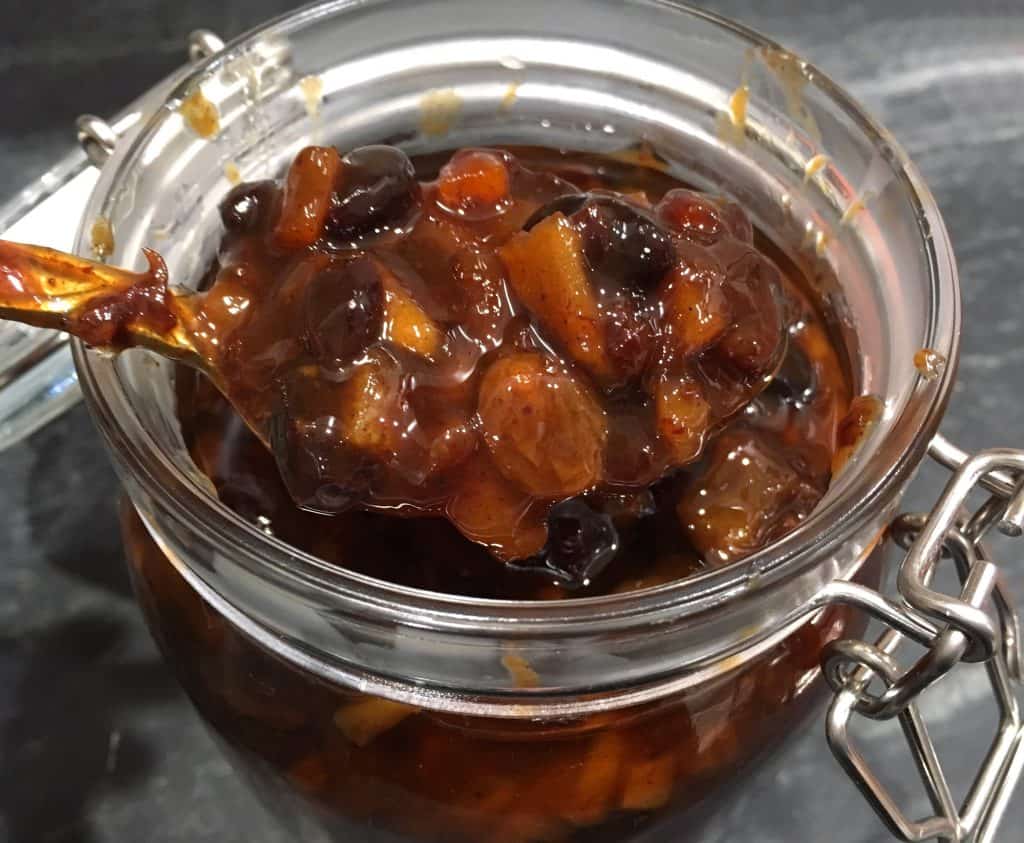
Few people today know the taste of true, authentic mincemeat, a dish dating back to the 11th century. And that explains why very few people I know actually truly enjoy mincemeat versus simply eating it out of tradition (or being forced to so as not to offend Grandma!). Sadly the authentic way of making mincemeat has been largely lost in the last century.
Whatever Happened to Traditional Mincemeat?
And I say lost, not because it’s been erased completely, rather because mincemeat has changed so much, some of its most important elements having been left out, that it just barely resembles its original ancestor. Of the many traditional British dishes that have undergone some form of alteration over the years, mincemeat has probably changed the most. That is largely due to the common omission of mincemeat’s two key ingredients: Meat (traditionally beef or lamb) and suet.
Things like wartime rations on meat, British culinary tastes moving away from sweet-savory combinations, and shifting trends away from the traditional use of suet (read my article on why you should use suet and lard – in short, medical research confirms our ancestors were right after all!) contributed to the gradual moving away from the inclusion of meat and suet in mincemeat. The result of these changes is manifest in the tiny mince pies of today that are almost sickly sweet without the savory meat and suet to round out the flavors and also fairly flat and one-dimensional in flavor profile without the complexity of the savory ingredients. This beloved dish of both the common folk and royalty (savored by generations of kings who enjoyed mince pies during their coronations and at their stately tables) sadly has been reduced to something that is a mere vestige, a residue, of what it once was – the spirits of centuries ago hover over what is passed off today as mincemeat while clenching their fists and wailing in agony.
Okay, that’s a little dramatic.
Essential Ingredients
Many generations ago people would experience mincemeat as a robust and sweet-savory meat-based mixture that conjured up what seemed like a thousand flavor sensations. Pair that with the incomparable texture that suet contributes to pie crust as it’s baked with the mincemeat and it’s no wonder that mincemeat pie was a heralded favorite for many centuries in the United Kingdom and then made its way to become a tradition in Canada, Australia, New Zealand, Ireland, Northern Europe, South Africa, and the New England region of the U.S..
Mince pies are still considered an essential accompaniment to holiday dinners today. But to be truly “traditional”, mincemeat requires meat and suet.

A note about SUGAR: Centuries ago mincemeat was far less sweet than it is today. Though it was made with fruits to add sweetness and to help preserve it (the fructose content), no sugar was added. Feel free to cut back on the brown sugar if you prefer.
A note about MEAT: If you’re put off at the thought of adding meat to mincemeat like our ancestors did for centuries, think of it this way: Imagine a Moroccan tagine – a dish of beef or lamb that is slow cooked with dried fruit, nuts and a myriad of aromatic spices. It’s downright amazing. Mincemeat, which not surprisingly originates from the Crusaders bringing the spices and method back with them from the Middle East, is a very similar concept: Beef that is simmered with dried fruits, nuts and a wonderful host of spices. That doesn’t sound so bad, does it? The mincemeat is stored for a while (under a layer of fat, a centuries-old method of preservation) so the flavors can deepen, and then it’s baked in a flaky pie. Heaven.
Why Make Your Own Candied Citrus Peel?
Another aspect that has always been off-putting to me about mincemeat is the overpowering flavor of the commercial candied citrus peel that’s called for in most recipes. It has a strong chemical-astringent flavor that many people dislike. For that reason I use and highly recommend making your own homemade candied orange peel for this mincemeat. Trust me, the flavor is incomparable and puts the store-bought stuff to miserable shame. And good candied citrus peel gives mincemeat an incredible flavor boost. That said, if you don’t mind store-bought candied citrus peel and want to save yourself the effort, feel free to use it. (Also, while not traditional, you can also include some Candied Ginger if you like.)
Check out my post on how to make Candied Orange Peel.

Why Use Suet?
While you “can” substitute butter (and even coconut oil, though that will greatly alter the flavor), I highly recommend suet for both flavor and texture, especially if you’re making mince pies. If you’ve ever made pie crust with suet you’ll understand – the end result is flaky and flavorful perfection unlike anything else. When you’re baking your mince pies the suet will bake into the pie crust enhancing texture and flavor.
I usually make my own suet when I have access to some kidney fat from locally-raised, grass-fed cows. Check out my tutorial on How to Make Beef Tallow. It’s super easy to make yourself. For a store-bought option I recommend Atora Shredded Beef Suet from England and a household name since 1893, but it’s usually extremely expensive to buy outside the UK.
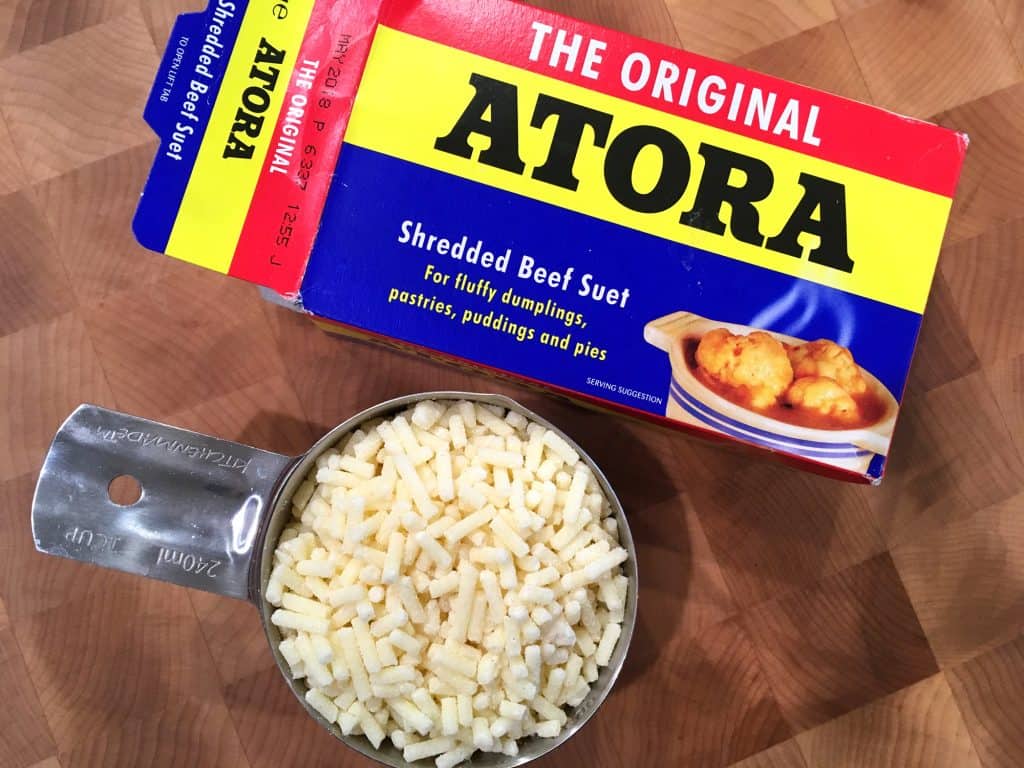
How to Can Mincemeat
A note about PRESERVING: Traditionally mincemeat would be made the year before it’s eaten to give the flavors time do develop and deepen. While time does improve it, it is delicious eaten within just a few days. However, if you want to store it there are several options:
Refrigerator: If you omit the meat it will last for up to a year in clean sterilized jars (some keep it several years in the back of the fridge). The layer of fat on top seals off the mincemeat from any air which results in food deterioration. This is a method of preserving that’s been used for many centuries. If you include the meat it will safely last in your fridge for up to 2 weeks.
Freezer: Either with or without meat, mincemeat can be frozen in airtight containers or in ziplock bags for up to 6 months.
Canning for long-term storage: If you want the traditional meat version to keep longer you can process the quart-sized (or pint-sized) mason jars (leaving 1 inch headspace) in a pressure canner (not a water bath). Spoon the hot mincemeat into sterilized quart or pint mason jars leaving 1 inch headspace. Use a clean moist rag to wipe off any oil from the jars. Seal and process in a pressure canner according to the time and pressure outlined in the chart below and the mincemeat will keep for up to a year:
| Recommended process time for a dial-gauge pressure canner. | ||||||
| Canner Pressure (PSI) at Altitudes of | ||||||
| Style of Pack | Jar Size | Process Time | 0 – 2,000 ft | 2,001 – 4,000 ft | 4,001 – 6,000 ft | 6,000 – 8,000 ft |
| Hot | Quarts | 90 min | 11 lb | 12 lb | 13 lb | 14 lb |
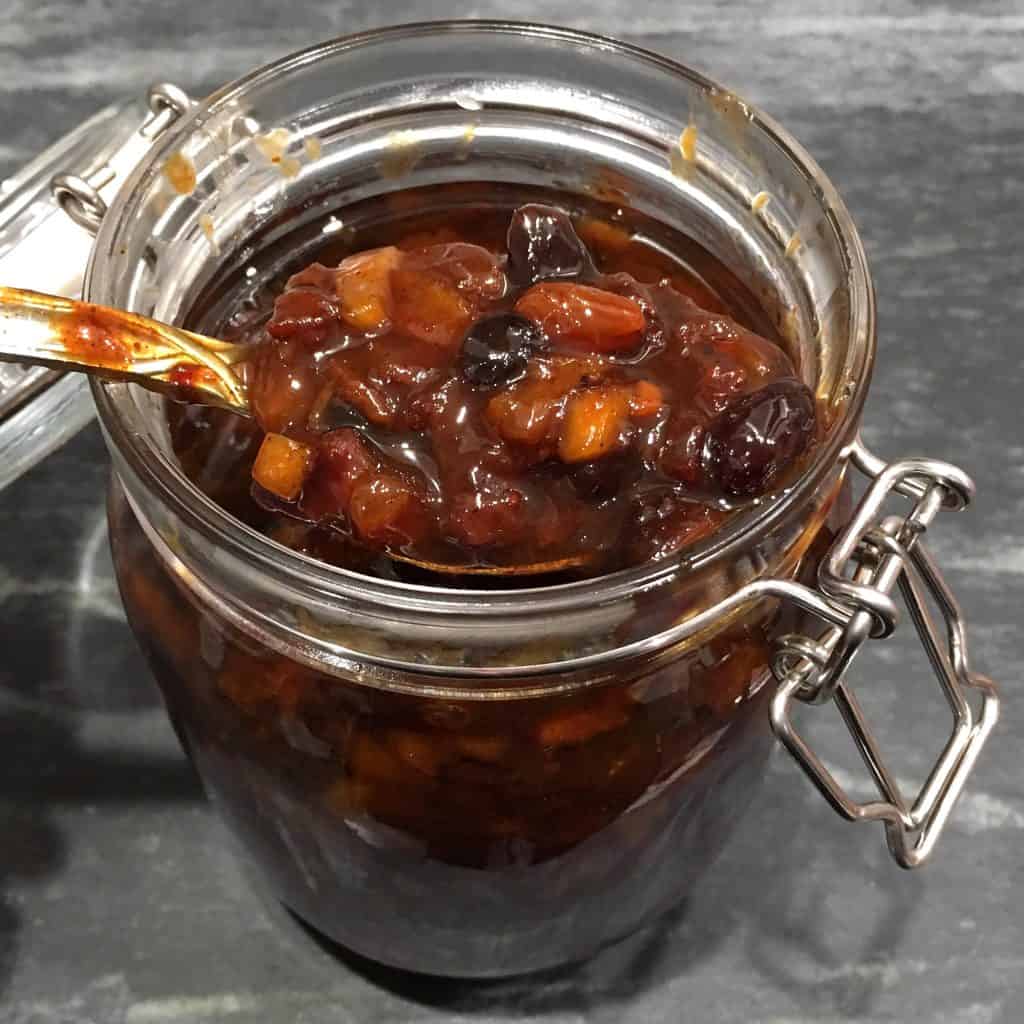
Mincemeat Recipe
Let’s get started!
Combine all of the ingredients, except for the brandy and/or rum in a medium-sized pot.
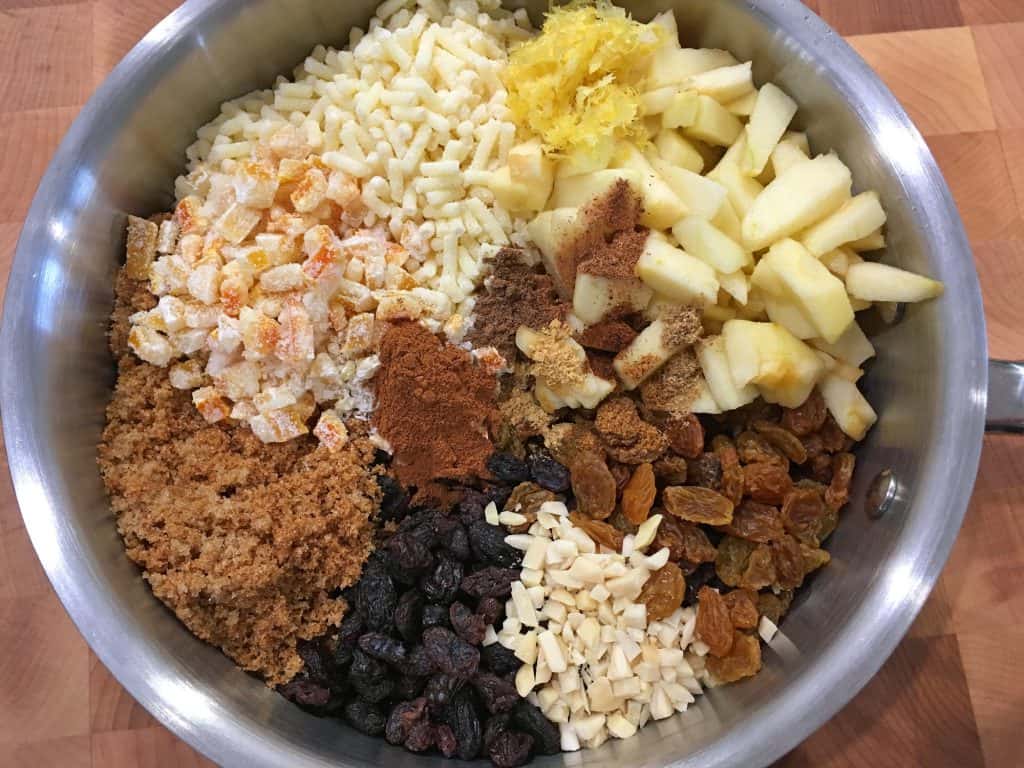
If you’re adding meat, which I highly recommend, you’ll add that at the same time.
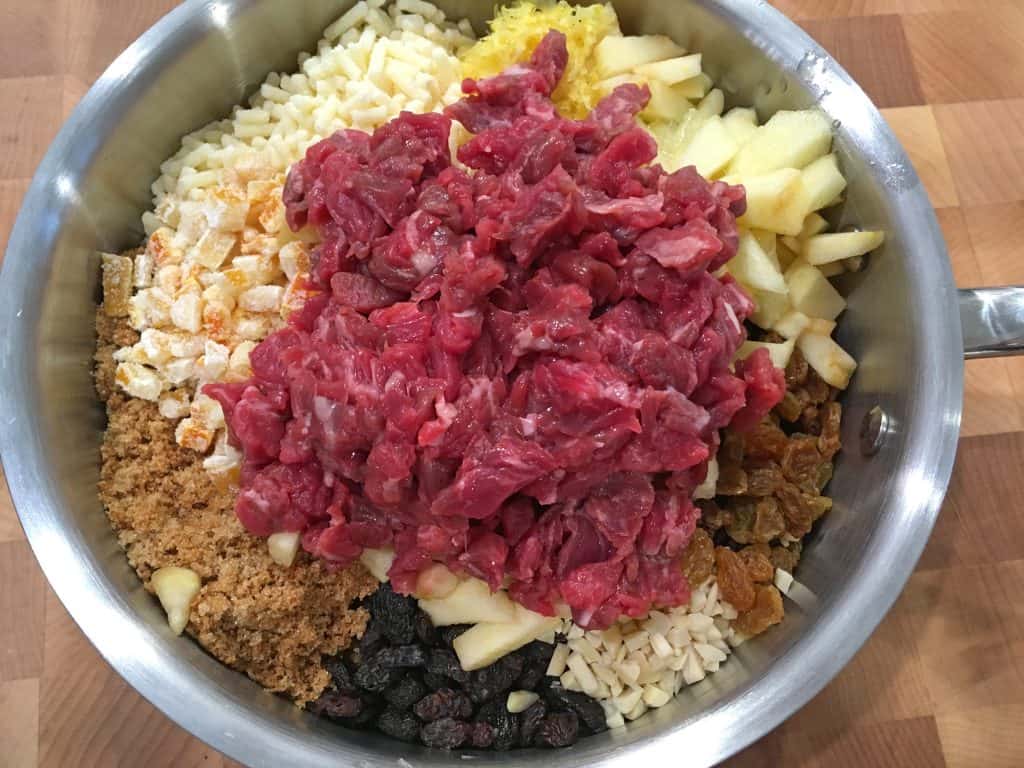
Bring it to a boil and then reduce the heat to LOW and simmer uncovered for about 2 hours, stirring occasionally, more towards the end to prevent burning. If the liquid reduces too soon and the mincemeat starts to stick/scorch on the bottom, add a little bit of apple juice or water.
At the end, stir in the brandy and/or rum. If you prefer to have the alcohol cooked out, add it at the same time as the other ingredients (note, the flavor of the brandy/rum will be less pronounced).
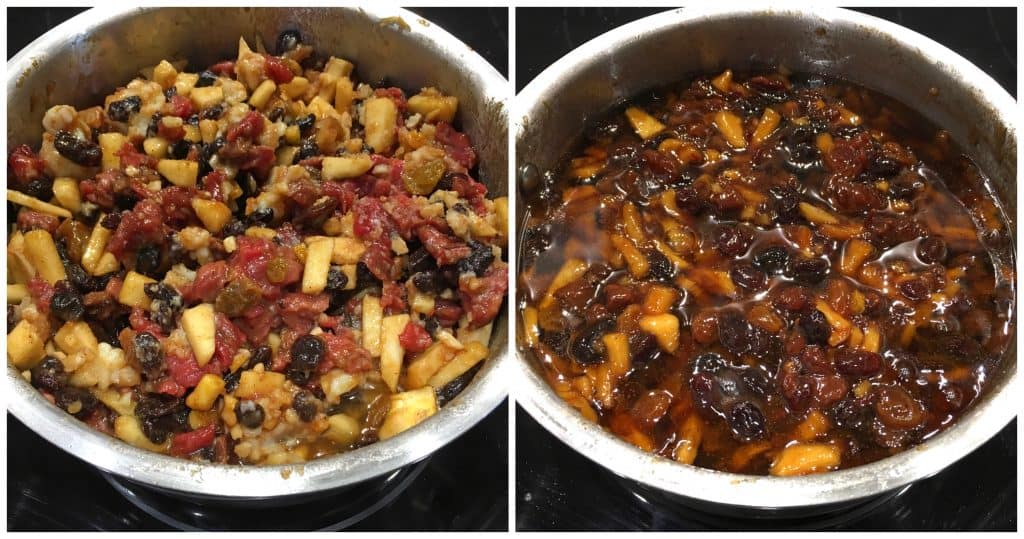
Pour the hot mincemeat into sterilized jars. Let the jars cools.

The liquid suet on top will gradually harden into a protective layer which will enable you to safely store your mincemeat.
**For instructions on different methods for storing your mincemeat, including how to can it for long-term storage, see the blog post section above on Preserving.
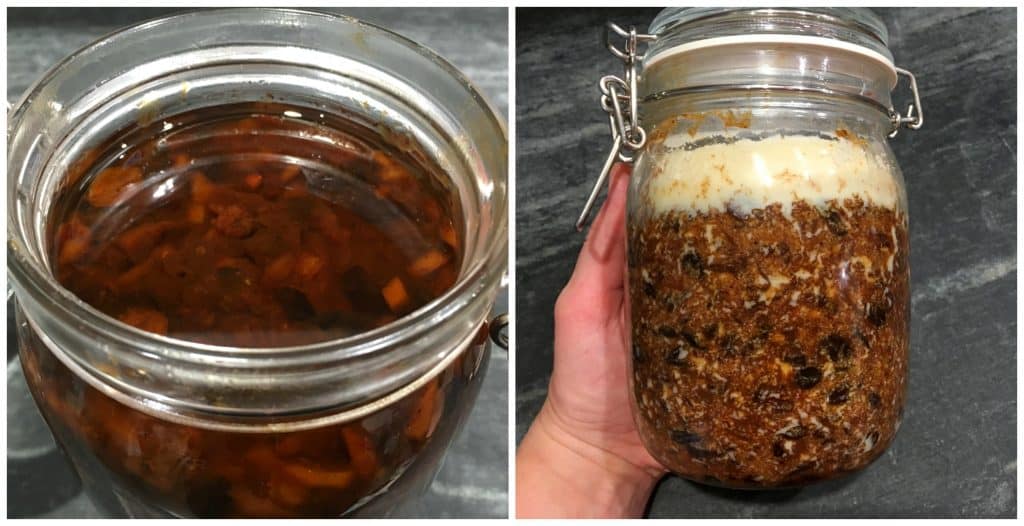
This mincemeat is delicious used immediately but for optimal flavor let it sit in the refrigerator for 1-2 weeks before using. If you’re including the beef in your mincemeat and plan on storing it for longer than a couple of weeks, follow the instructions above for pressure canning your mincemeat.
Now you’re ready to use this mincemeat to make homemade Mince Pies! Or create your own twists by using it for things like mincemeat cake or mincemeat muffins
Enjoy!

For more delicious traditional British treats, be sure to try our:
- Sticky Toffee Pudding
- Lardy Cake
- Eccles Cakes
- Spotted Dick
- Bara Brith
- Barmbrack
- Mince Pies
- Scottish Shortbread
- Yorkshire Parkin
- Flapjacks
- Victoria Sponge Cake
- Crumpets
- Millionaire’s Shortbread
- Yorkshire Pudding
- Figgy Pudding
Save This Recipe
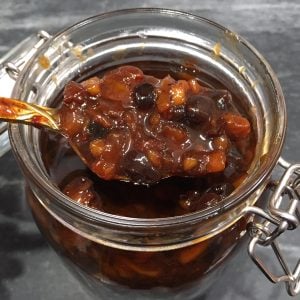
BEST Traditional Mincemeat
Ingredients
- 1 pound (450 grams) finely chopped beef steak , (optional but HIGHLY recommended, otherwise use an extra 1 1/2 cups raisins or currants) **Use a well-marbled cut so it will be tender after the long cooking time; if the cut is lean it will become over-cooked and tough
- Note: Traditionally made with beef or lamb and can also be made with wild game
- 1 1/4 cups (190 grams) raisins
- 1 1/4 cups (190 grams) currants
- 1/2 cup (80 grams) golden raisins
- 2 cups finely chopped tart apple
- 7 ounces (200 grams) shredded beef suet (you can also ask your local butcher for fresh beef suet ground through a fine meat grinder)
- 2 cups (450 grams) packed dark brown sugar
- 2 tablespoons candied lemon peel
- 2 tablespoons candied orange peel
- STRONGLY recommend using Homemade Candied Citrus Peel (click link for recipe)
- 1 1/2 tablespoons (25 grams) finely chopped blanched almonds
- 1 lemon, its zest and juice
- 2 tablespoons apple cider vinegar
- 1 1/2 teaspoons ground cinnamon
- 1/2 teaspoon ground nutmeg
- 1/4 teaspoon ground cloves
- 1/4 teaspoon ground allspice
- 1/4 teaspoon ground mace
- 1/4 teaspoon ground ginger
- 1/4 teaspoon ground coriander
- 2 tablespoons brandy
- 2 tablespoons dark rum
Instructions
- Combine all ingredients except for the brandy and rum in a medium-sized pot and slowly bring to a simmer to prevent scorching. Reduce the heat to LOW and simmer uncovered for about 2 hours, stirring occasionally, more towards the end to prevent burning. (If the liquid reduces too soon and the mincemeat starts to stick/scorch on the bottom, add a little bit of apple juice or water.) Stir in the brandy and rum. (Note: If you prefer to have the alcohol cooked out, add them at the same time as the other ingredients.)
- Spoon the hot mincemeat into sterilized jars (spooning it in the jar while hot will ensure the suet rises to the top to create a layer of fat). As the mixture cools the suet will harden, creating a seal to help preserve the mincemeat. *If you're including the beef be sure to refrigerate the mincemeat. If you're storing it for more than a couple of weeks follow the directions in the blog post for pressure canning the mincemeat for longer-term storage.See blog post for additional ways of storing your mincemeat.
- Makes about 1 quart. Feel free to double, triple, etc, as needed.Use this mincemeat to make homemade Mince Pie (click link for recipe).
- Note: Mincemeat is traditionally stored for several months before using to allow time for the flavors to deepen, however this mincemeat is also delicious eaten within just a few days.
Notes
Nutrition
Originally published on The Daring Gourmet December 16, 2017



















This is a great recipe, but I’ve made a some modifications of it to make it my own. The biggest one, and I strongly recommend it for anybody trying a true mince-*meat*, is to make sure the meat flavor comes through. This involves browning the meat and adding salt. What I do – I hand-mince a round steak and cut it down to chunks that are a larger than a full hamburger-style mince you’d buy at the butcher. I start out the cooking by adding the meat to few tablespoons of the beef drippings (which I use instead of suet). I brown the meat, per this recipe (www .thekitchn.com/how-to-cook-brown-ground-beef-cooking-lessons-from-the-kitchn-179756) and throw a teaspoon or two of ground sea salt on the meat. Once it’s fully browned, I deglaze with 1 1/2 tablespoons each beef stock and soy sauce. Then I add the other ingredients in the recipe. What I end up with is *really* good with a well developed meaty/umami flavor that balances wonderfully with the sweet ingrediants. It makes a huge difference – the first time I made this recipe, I didn’t add the salt or the stock and soy, and the meat faded into the background – this method really brings it out.
Other modifactions I make. I use half the amount of sugar – 1 cup rather than 2, and it’s still plenty sweer. I use dark muscovado rather than dark brown sugar; muscovado sugar has an incredible flavor. I replace part of the sultanas/currents/raisins with other dried ingredients – figs, and also my own innovation, candied wild mushrooms (candy caps and chanterelles), which add a wonderful flavor. I’m a mushroom hunter, and it’s one of the kinds of preserved mushrooms I prepare during the late summer mushrooms season.
Other mods – replacing some of the apple with quince. Rather than lemon, I use Seville (marmalade) orange juice and zest. I modify the spice mix a bit, cutting the nutmeg in half and adding some mace, and also add star anise, black pepper, juniper berries, and thyme in addition to all of the spices in your recipe. And, of course, being in Ireland, I use Irish whisky (a good half cup) instead of rum and brandy, and I add it at the very end, off heat.
I use this recipe when I make the final pies: www .bbc.co.uk/food/recipes/paul_hollywoods_mince_04604. Basically, you combine the mince with some fresh Bramley apple and clemantine, which I prefer as a filling to 100% mincemeat.
This is now my winter baking go-to, though I end up making after Christmas, as marmalde oranges only come into season in January. Anyway, thanks for giving me a great recipe that I was able to make my own!
I liked your recipe for mincemeat exactly as you described YOUR recipe. For those who have made more modifications than this recipe is as king then it’s your recipe and go get your own website. How insulting.
Thanks buddy. Just keep doing what you do best. Help those who appreciate it.
Warmest regards
Scott
I have never made this before, but I have a variety of dried fruits and nuts leftover from the holidays. How do you feel about a combination of dried dates, raisins and cranberries? Also nuts. I have brazil nuts, walnuts and pecans, can I use any of those chopped into my mincemeat? I have rendered grass fed beef fat (from the beef loin) in my fridge – is that acceptable to use as “suet”? USA here – suet is what I put out for birds, LOL!
Hi Anita, yes, you can substitute any combination of those dried fruits and nuts. Yes, you can use the rendered beef fat for this. Just FYI, for most British baked goods calling for beef suet you will need the actually “shredded” beef suet that has not been rendered. The reason being is that the shredded beef fat gradually melts as the baked good is baking or steaming (i.e., steamed puddings) creating pockets/holes the yield the characteristic light spongy texture. But you can get away with regular rendered beef fat for Mincemeat.
Made this for the first time last year and have made three batches this year since everyone spread the word last year how awesome it is. I have another request in to ship a few pies to a friend and will be going to the store next week to get some supplies I’m out of. I’ve only had one person who didn’t care for this mincemeat and it’s just not what she was used to with her family. Not sweet enough. I am so happy you posted this recipe! It’s definitely one of my favorites to make and so easy.
That’s wonderful, Susan, thank you so much!
Very nice and easy. I am a vegetarian so added more blaccurrents
Absolutely wonderful recipe. I lived in Alaska 10 years, 5 in the bush or off the grid. I had to ship some of the fruits by air and I also used low bush cranberries dried and reconstituted. The meat I used was Moose meat. I used the little fat there was from the Moose which is not much, as they’re very lean animals. It was wonderful but not my husbands favorite. Since returning to live in the lower 48 I now have my niece send me Moose meat roast for my mince pies.
Thank you for your ideas on preserving the meat mixture, the saving of the suet and use in other foods and the few extra spices that were not on my list, they have made a world of difference in flavor.
Thank you so much, Linda, I’m so glad you enjoyed it and appreciate your feedback!
If I use canned mincemeat, how can I cook some meat to add to it?
Hi Lindsey, I can’t say how good the end result will be but you would just need to add everything to a pot and simmer it together.
Wasn’t sure of what “finely chopped meant” with regards to the meat.. and 15 minutes was a bit of an exaggeration of time to prepare, but the recipe is great and a keeper..
I made and used the clickable recipe for candied citrus peels (prepared ahead), also a great recipe. I’ve made it twice, still not sure about cutting the meat, and burnt it on the bottom second time even though cooking on low with lots of liquid still boiling at the end (needed more attentive stirring).
The flavors are marvelous together and I’ll try it again with slightly larger cuts of meat and more apple pie sized apple cuts…and more stirring :)
Hi Joseph, I’m happy you enjoyed it, thank you! Yes, as noted stirring more frequently towards the end is especially critical to prevent burning.
My Grandmother remembers that her mother-in-law would go to a neighbor when he butchered his hogs in the fall to get the meat for her mincemeat. My grandmother said it was the best mincemeat she ever had but couldn’t find a recipe card when Great Grandmother died. I realize that hogs raised on small farms 100 years ago would taste nothing like the pork we have today but has anyone tried mincemeat with pork and how was it?
Awesome story 🙂
I have always added pork to my mincemeat and it was wonderful.
Got the recipe from my mother-in-law. My kids always cringe when I tell there’s meat in it, but I love it!
I was looking forward to my first attempt at making true mincemeat but hit a snag. There was quite a discrepancy in the amount of the dried fruits depending on whether I measured by weight (grams) or by volume (cups). For instance, when I measured out 1 1/4 cups of currants they did not weigh in at the corresponding 330 grams In order to meet the grams listed, I would have needed to add about 3 cups of currants in total. I am at an impasse and would welcome your recommendations as to how to handle this conundrum.
Hi Joyce, the cup measurements are correct and I don’t know what caused that weird glitch with the metric conversions. I reached out to the software developer about it and it’s corrected now. I apologize for that.
Hi Kimberly. My Mother used to make her version of mincemeat pies when I was a kid. I am curious to try your recipe. You don’t mention the pie crust. Do we just use whatever we would normally for other pies? And is the lard within the cooked mincemeat what you say will bake into the crust? I suppose that some of the lard at the surface could be used in the crust.
Hi Patty, I link to my mincemeat pie recipe in the blog post. Here it is: https://www.daringgourmet.com/traditional-mince-pies/ Yes, the lard that’s mixed up in the mincemeat will make the pie crust extra delicious. And yes, you can definitely use the top layer of lard to make pastry crust and other pastries.
Hi its also my first time making the mincemeat with beef. I am a little confused on how long it will keep cooked in a steril jar in the fridge. Is it a max of 2 weeks or minimum? Thanks in advance
Hi Ross, if you’re making it with beef I recommend storing it in the fridge and using it within 2 weeks. If you plan on storing it longer than 2 weeks I recommend pressure canning it.
Hi Kimberley, even if the meat is cooked?
Yes, if you’re following this recipe the meat is cooked with the rest of the filling ingredients and you can then store it in the fridge for up to 2 weeks.
I have made this recipe several times and have been very pleased.
I also found the weight/volume issue. I have the recipe up on two computers, same website, different computers. On one 1 1/4 cps = 330grams. On the other 1 1/4cps = 190 grams. I weighed 1 1/4cps and it closer to 190 grams. But, the bigger issue is why does one computer show 330 grams while the other shows 190 grams? Maybe it is a problem with the coding?
Hi James, I’m happy you enjoyed the mincemeat!
The version with the 190 grams measurement is correct. Likely the page showing the 330 grams hadn’t been refreshed once the software glitch was updated.